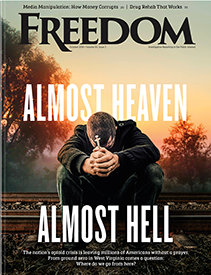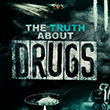
When Freedom magazine’s Associate Editor Michael Brennan began looking at America’s opioid crisis last year—the centerpiece of this edition—he didn’t have to look far to hear stories about the social impact of drug devastation and despair. They were on television, on the radio, the subject of news programs and analysis, had filled columns of newspaper space and shocked readers in magazine photo spreads. The picture was not pretty.
But for all the examination by the commercial media of this pharmaceutical industry-driven epidemic—which to date has caused tens of thousands of overdose deaths, exceeding even the combat death toll in Vietnam—the statistics, the concerns of health officials, the outcry from affected families, it has still been largely ignored.
Those stories in our drug advertising-dependent media have spoken only to a hopelessness, an impotency among government and health officials in dealing effectively with one of the worst social debacles in the nation’s history. And in large measure, they have failed to delve into the heart of the matter—the human toll.
That impotency to legislate, to punish profiteering pharmaceutical industry executives responsible for this health crisis, seems to be fully reflected in recent public comments by U.S. Surgeon General Dr. Jerome Adams.
In May, Dr. Adams spoke to the American College of Emergency Physicians in Washington, D.C., and talked about needle exchange programs, about creating “safe” places to inject drugs, and his support for such treatments as buprenorphine, itself an opioid that gets users “high” but is less potent than heroin or its cousin, methadone.
In a recent visit to West Virginia’s Cabell County—ground zero in the national epidemic—he characterized the devastated community’s emergency responses to overdoses as “one of the best stories in the United States in terms of recovery.” Perhaps he should have spent more time in the local emergency rooms than in the conference rooms.
More significantly, he has been carrying a message in his travels around the country that touts the lifesaving benefits of the drug “naloxone”—primarily known as Narcan—the over-the-counter rescue drug for opioid and heroin overdose. He has encouraged everyone in the country to carry it—and recognize the symptoms of an overdose—in case they get a chance to save a life.
Maybe the nation’s surgeon general doesn’t see the irony here.
Pharmaceutical companies engorged themselves on decades of profits by peddling massive amounts of painkillers to an unsuspecting public. Investors in those often publicly-traded companies have also grown fat on the backs of the misery they helped create. Now, with “rescue” drugs that Dr. Adams wants handy, just in case, drugmakers are making more profits.
The surgeon general’s solution is no solution at all. As Freedom’s investigation shows, opioid addicts who subsequently shored up the market for dangerous street drugs like heroin, live to die another day. The causes of addiction, responsible treatments, the enabling mechanisms of the Food and Drug Administration, the indifference of Congress to holding anyone accountable, are not the focus of Dr. Adam’s public relations campaign. Perhaps next he will advocate for a shovel in every household to bury our dead. He is already burying his own head in the sand.
Naloxone may save lives in a crisis but until the causes of addiction are addressed in a responsible way, the death toll will continue to rise, as it has in Illinois with a 34 percent increase between 2015 and 2016. On a tour of the state’s Kane County health department, Dr. Adams had this to say:
“I’m here today mostly to tell you to stay the course. Keep doing the things that you are all doing, because they are making a difference, even though the epidemic seems like in many ways it may be getting worse.”
But it is getting worse. And the rose-colored glasses through which the leader of the nation’s health administration appears to be gazing are obscuring the truth.
Naloxone may save lives in a crisis but until the causes of addiction are addressed in a responsible way, the death toll will continue to rise.
Freedom magazine—which does not rely on advertising—was one of the first publications in the country to raise the alarm about painkiller addictions. In the early 1980s, this magazine was issuing warnings and writing about the pharmaceutical manufacturer’s irresponsible excesses and profiteering that were only then building the foundations of this health crisis.
Our most recent examination should be writing an epitaph for an epidemic. But it is not. The problem is alive and well—while loved ones of so many families in American communities are not.





































